With its proud bearing, abundant coat, and compact body, the Pekingese is truly a royal breed. Originating centuries ago in ancient China, members of the imperial family cherished these petite dogs. Today, the Pekingese continues to captivate dog lovers from all walks of life with its confident and affectionate personality. There’s never a dull moment with these lively and clever companion dogs! Read on to learn more about this dignified breed and what to expect from adorable Pekingese puppies.
Table of Contents
- 1 An Ancient Breed of Chinese Royalty
- 2 The Signature Pekingese Appearance
- 3 The Playful, Affectionate Pekingese Personality
- 4 Grooming the Magnificent Pekingese Coat
- 5 Exercise Needs for Pekingese Puppies and Adults
- 6 Health and Care Tips for Pekingese Puppies
- 7 Tips for Training Pekingese Puppies
- 8 Finding a Responsible Pekingese Breeder
- 9 Bringing Home Your Pekingese Puppy
- 10 The Dignified Yet Lively Pekingese
- 11 Related posts:
- 12 Pekingese Dog Breed: Facts, Characteristics & Care
An Ancient Breed of Chinese Royalty
With its abundant mane, bold topknot, and stocky body, the Pekingese certainly looks the part of Chinese royalty. The breed’s history spans over 2000 years to the Han Dynasty in ancient China. Members of imperial households treasured Pekingese dogs and became symbols of aristocratic status.
These petite “sleeve dogs” were small enough to fit inside the ample silk sleeves of their Chinese masters. The emperors and their families took great pride in breeding the perfect Pekingese specimens. Throughout Chinese history, lions—meant to convey courage and dignity—were born with the most miniature breeds, like Pekingese and pugs, to create an imperial companion dog.
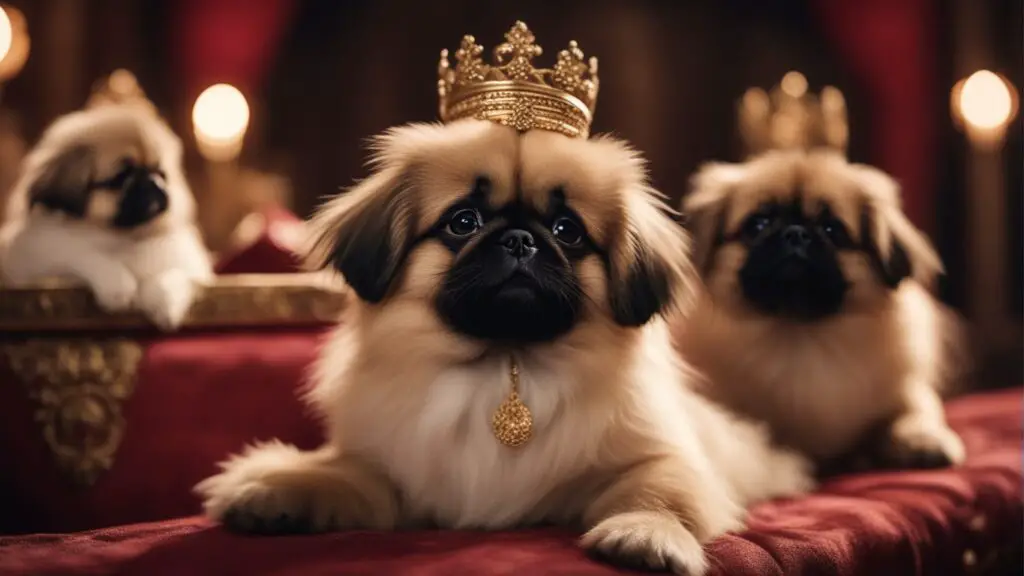
Over the centuries, these Chinese nobles went to great lengths to protect their regal Pekingese dogs. There are stories of palace guards and even armies deployed to save valued Pekingese pets! When British forces raided the Chinese imperial palace in 1860, five Pekingese were returned to England. These little lion dogs captivated the Victorian public and kickstarted Pekingese breeding programs in Britain and beyond.
Thanks to their association with Chinese nobility, Pekingese dogs still convey an air of importance and self-assurance. That proud head held high gives them an undeniable perspective of royalty!
The Signature Pekingese Appearance
One look at the Pekingese and it’s easy to see why they were prized by Chinese nobility. These petite yet muscular dogs weigh 7-14 pounds and typically stand about 6-9 inches tall at the shoulder. They have a broad, pear-shaped body and sturdy, slightly bowed legs to support their compact frame.
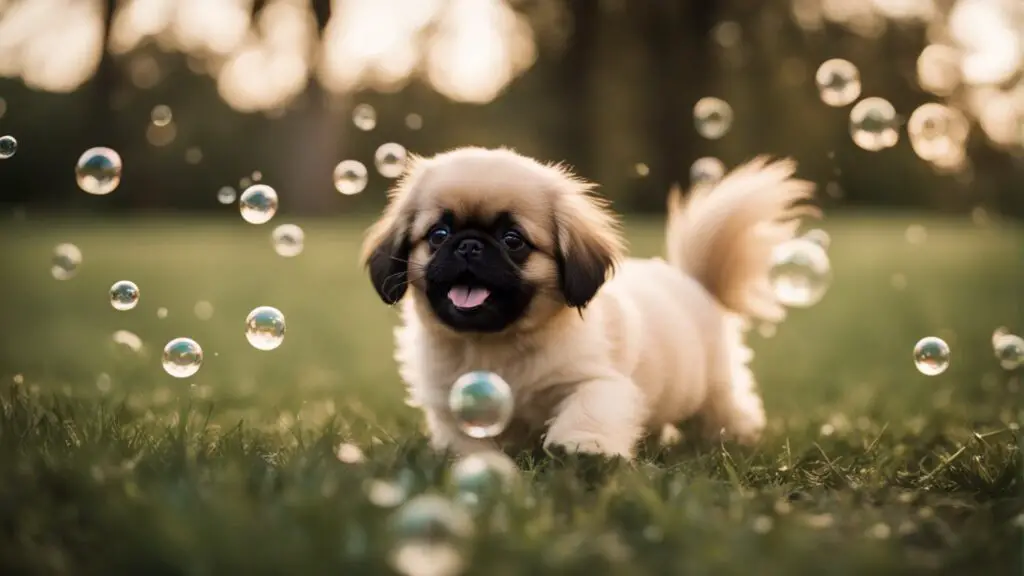
The Pekingese’s most glorious feature is undoubtedly its abundance of mane-like fur. A long, coarse outer coat combined with a thick, soft undercoat gives the Pekingese a leonine appearance. This impressive double coat is heavy even by the standards of a northern breed. A Pekingese’s straight outer skin forms a noticeable fringe around the head, neck, forelegs, and thighs. The breed’s tail is covered in long, straight fur as well. Grooming these flowing featherings daily is a must!
The Pekingese has a broad head featuring a wrinkled muzzle, a black nose, and large, dark eyes encircled by black eye rims. This brachycephalic (short-muzzled) breed sports a characteristic black mask over the face. Combined with the mane and bold gaze, this facial mask gives the Pekingese its decidedly leonine look. Those petite triangular ears fringed with fur complete the royal appearance.
The Pekingese has various colors: black, black, tan, cream, fawn, grey, red, white, and particolored coats. No matter the color, the Pekingese always make a stately impression.
The Playful, Affectionate Pekingese Personality
Despite its aristocratic heritage, the Pekingese have a surprisingly playful and people-oriented personality. Pekingese puppies are lively, fun-loving balls of energy. These independent dogs are also quite affectionate with family members and love nothing more than curling up on a lap for petting sessions.
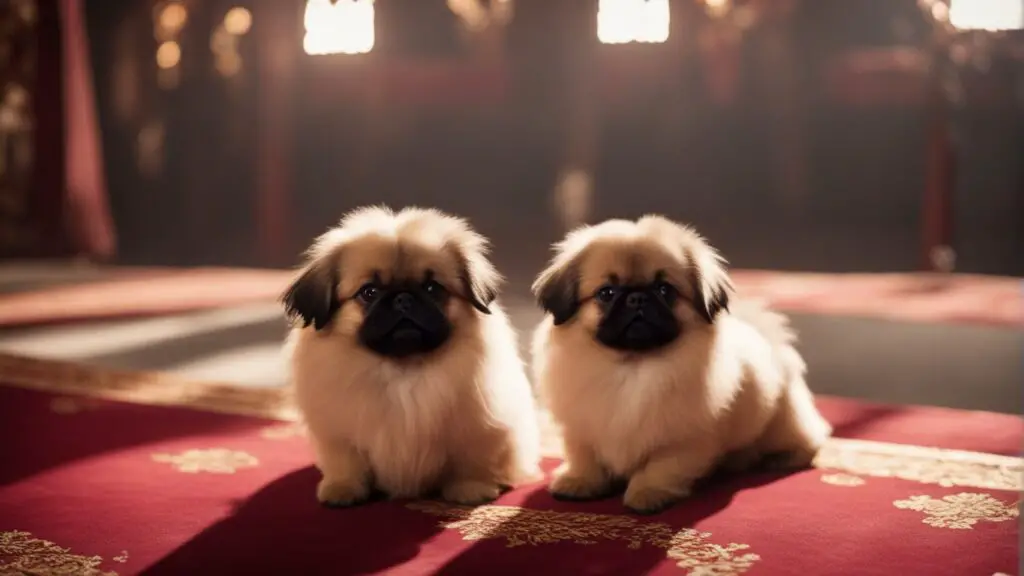
Since they were bred to be companions, Pekingese thrived on quality time with their favorite people. They enjoy being the center of attention—as any regal breed should!—and usually have a sense of humor about their royal status. Pekingese also make excellent watchdogs; that bold, suspicious nature kicked in if strangers approached the palace grounds.
While Pekingese are devoted to their families, they can be more aloof or wary of strangers. Early socialization is essential to prevent these dogs from becoming overly suspicious. Reward-based training works best with this free-thinking breed.
With their dignified attitude, Pekingese can be stubborn at times. But that strong will also means Pekingese are pretty clever and respond well to activities that challenge their minds. Food puzzles, trick training, and interactive toys will keep your Pekingese pup engaged and entertained for hours.
Grooming the Magnificent Pekingese Coat
That abundant double coat is the glory of the Pekingese breed—but it also requires regular upkeep. Expect to spend 20-30 minutes brushing your Pekingese puppy daily to prevent mats and tangles from forming in that long topcoat and thick undercoat. A wire-slicker brush followed by a metal comb reaches right down to the skin and pulls out loose hair before it matures.
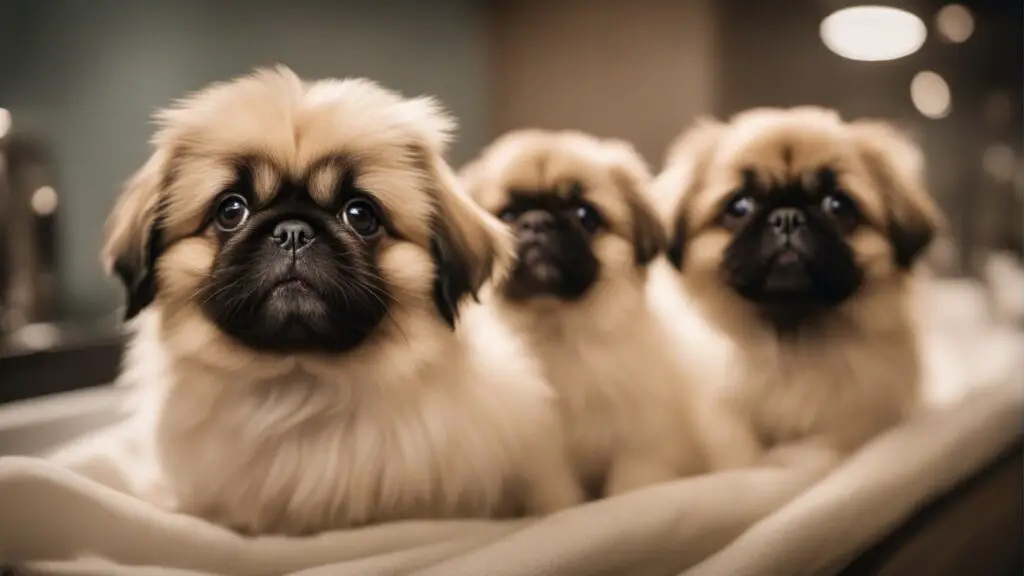
Pay close attention to the featherings since these easily tangle if not brushed thoroughly. Trimming the hair around the feet helps minimize debris brought indoors after outdoor excursions. Keeping the fur around the eyes neatly trimmed reduces tearing issues in this brachycephalic breed.
Daily brushing is the only way to manage heavy shedding with Pekingese dogs. Their dense double coat blows seasonally in the spring and fall. Outside of shedding season, expect lots of hair around the house too. Hand stripping or clipping the coat 2-3 times a year can minimize shedding between full-blown skin blows.
Despite the grooming requirements, that gorgeous coat makes it all worthwhile! A well-groomed Pekingese wears its regal mantle proudly.
Exercise Needs for Pekingese Puppies and Adults
Despite their dainty size, Pekingese puppies are lively, energetic little dogs. They enjoy brisk walks and active playtime each day. Adults are slightly calmer but still benefit from daily exercise. A customary 20-30 minute walk or indoor play session keeps Pekingese at a healthy weight and satisfies their exercise needs.
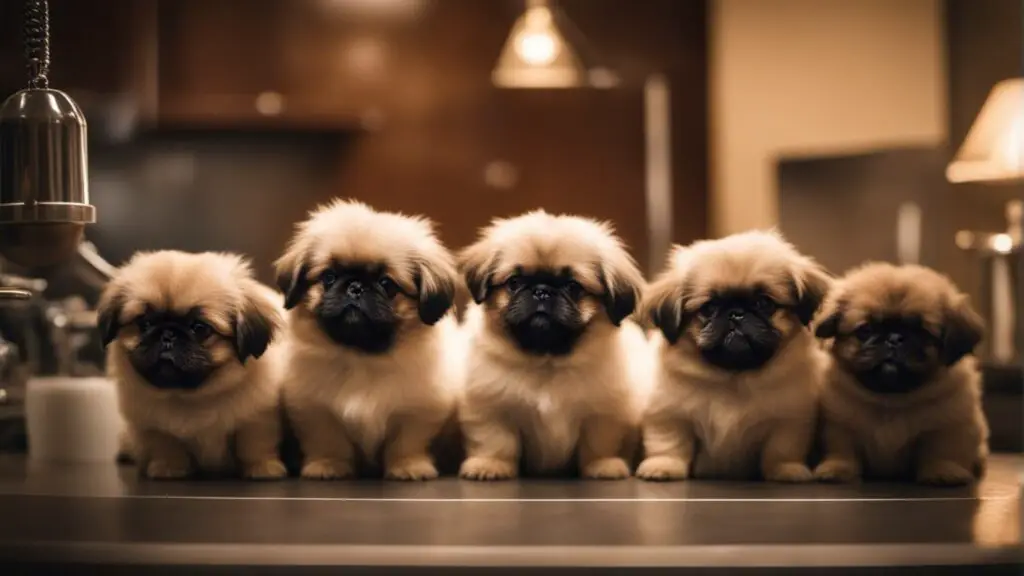
These brachycephalic dogs fare better in temperate weather. Limit exercise on sweltering, humid days since Pekingese can overheat quickly. Cool mornings or evenings are better times for walks. Provide access to fresh water and shade when outdoors.
Pekingese love exploring the outdoors, but their small size makes them vulnerable to other dogs, wildlife, and cars. Walk them on leash in safe areas only. A properly fenced yard gives them room to romp safely. Interactive toys, trick training, or fun nose work games provide mental stimulation indoors.
Health and Care Tips for Pekingese Puppies
The compressed muzzle and bulging eyes of the Pekingese make them prone to specific health issues. Reputable breeders screen breeding dogs for these heritable conditions. Once you bring home a Pekingese puppy, regular veterinary care helps keep them healthy.
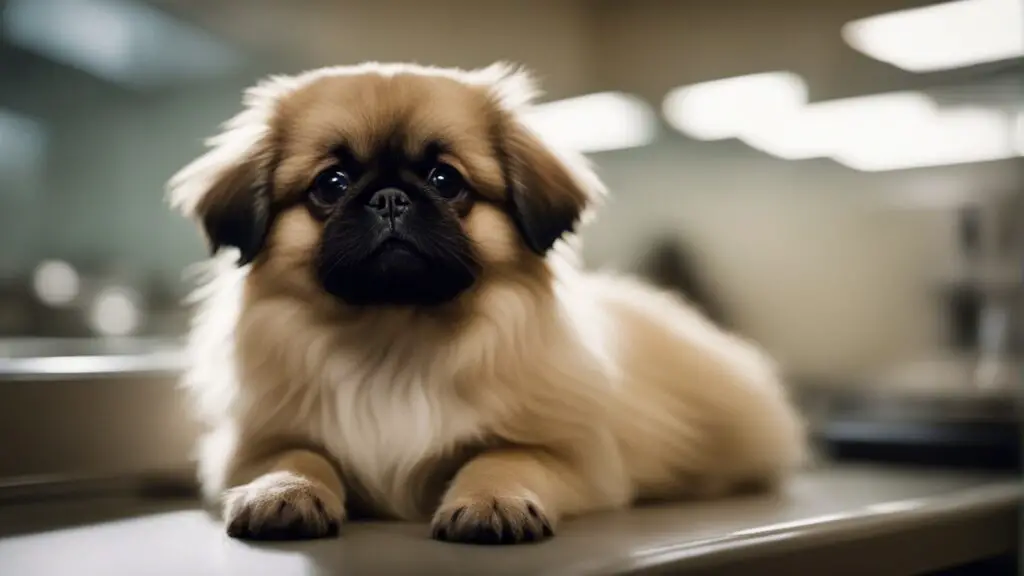
Some common health issues in Pekingese include:
- Brachycephalic Obstructive Airway Syndrome – Severe breathing issues due to narrowed airways and pinched nostrils. Keep Pekingese slim and avoid extremes of hot and cold weather.
- Luxating Patellas – Dislocated kneecaps are painful and can require surgical repair in severe cases. Ask breeders if parents were screened.
- Eye Diseases – Entropion, cherry eye, and keratoconjunctivitis sicca. Trim the fur around the eyes to prevent irritation.
- Dental Issues – Crowded, misaligned teeth prone to periodontal disease. Brush teeth daily and provide dental chews.
- Intervertebral Disc Disease – Minimize risks by preventing obesity, providing ramps/steps to avoid jumping on/off furniture, and proper leash walking. Neurological signs require immediate veterinary attention.
- Allergies – Both food and environmental allergies are common. Manage with good nutrition and proper grooming.
With extra care and routine vet visits, most Pekingese live long, relatively healthy lives of 12-15 years. These devoted companions reward their families’ loving attention.
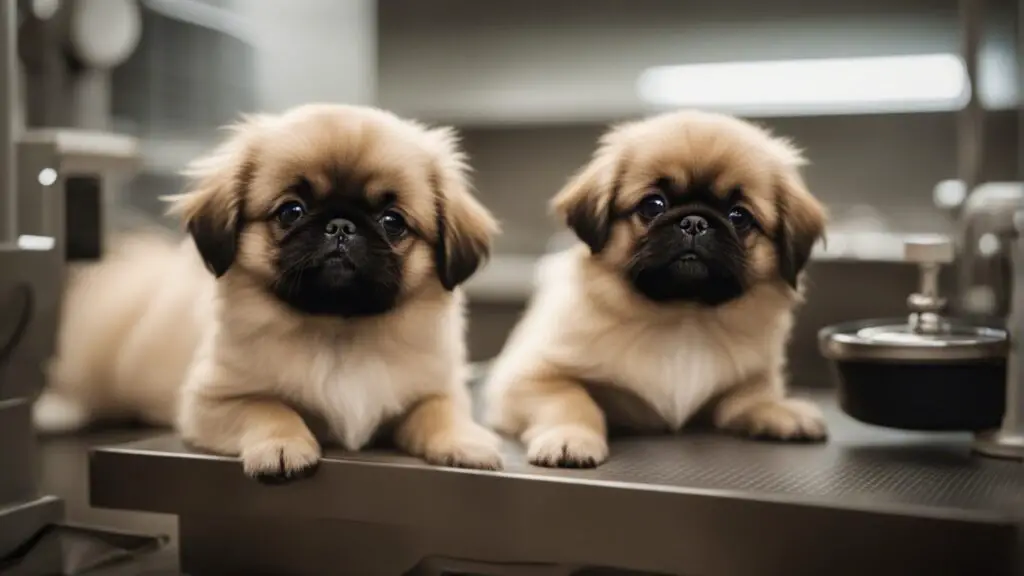
Tips for Training Pekingese Puppies
Intelligent, confident Pekingese can be independent thinkers—not the most straightforward combination for training! But Pekingese puppies thrive with positive, reward-based methods focused on respect and relationship building. Here are some tips:
- Use food rewards and praise to motivate Pekingese during training sessions. But avoid bribery—make them work for rewards!
- Remain patient and consistent. The key is perseverance with this stubborn breed—end sessions on a positive note.
- Socialization from an early age is crucial. Safely expose Pekingese puppies to new places, people, pets, and experiences.
- Focus on building respect. Pekingese dogs respond better to training that builds trust and two-way communication.
- Use their intelligence—Pekingese love learning new tricks and playing games that challenge their minds.
- Crate training assists with potty training and preventing destructive behaviors when you can’t supervise directly.
- Obedience classes provide structured socialization and training. Look for positive reinforcement methods.
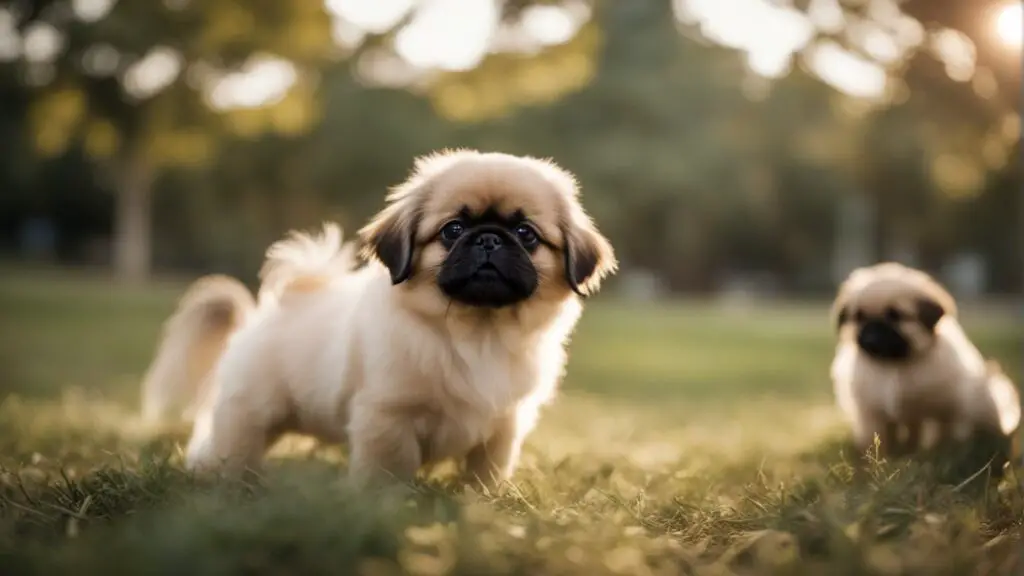
While they have a stubborn streak, Pekingese puppies adore their families and respond wonderfully to positive motivators like praise, play, and rewards. Put in the training time, and you’ll have a delightful companion.
Finding a Responsible Pekingese Breeder
The imperial Pekingese dogs were closely guarded for centuries. Today, it’s possible to find Pekingese puppies from breeders worldwide. However, take care to seek out responsible breeders who health test their dogs and breeding stock.
Avoid pet stores or irresponsible breeders who mass-produce Pekingese litters without regard for breed standards or health. These poorly bred puppies often have solemn temperament and health issues.
Instead, look for breeders who:
- Have decades of experience with purebred Pekingese dogs
- Test all breeding dogs for genetic issues like luxating patellas, eye disorders, and cardiac problems.
- Raise puppies in a clean, caring environment and provide age-appropriate vet care and socialization.
- Carefully screen potential owners to ensure puppies go to lifelong homes.
- Offer support and guidance for the puppy’s lifetime, not just during the sale.
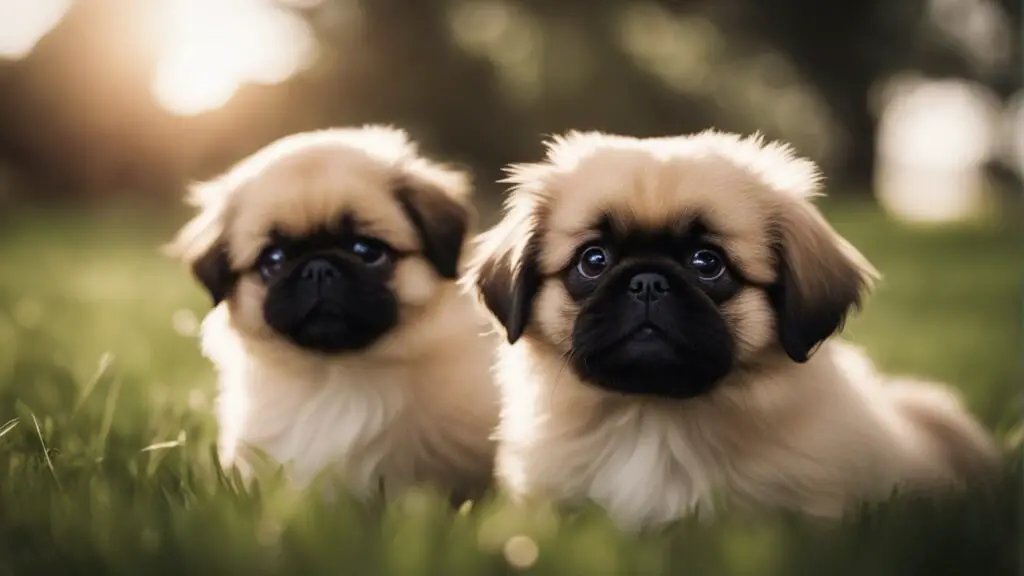
Connect with local Pekingese breed clubs to find reputable breeders in your area. Be prepared to wait for the right puppy rather than rushing the process. A well-bred Pekingese from health-tested lines will become your delightful companion for years.
Bringing Home Your Pekingese Puppy
Once you’ve found a responsible breeder, prepare everything your Pekingese puppy will need in advance. Puppy-proof your home by removing dangerous objects, installing baby gates, covering electric cords, and securing household toxins. Stock up on food, bowls, a collar and leash, toys, and other supplies.
Choose a crate with room for your Pekingese to stand up, turn around, and lie inside. Introduce this slowly as their safe space, not a punishment. Maintain a consistent daily schedule, including potty breaks, playtime, training sessions, and meals. At this young age, interacting with your Pekingese constantly helps build strong bonds.
Socialization is also critical during this impressionable window. Safely expose your Pekingese puppy to new places, people, animals, sights, and sounds. Invite friends over to meet your pup. Carry them in public (once vaccines are complete) so they acclimate to new environments. Positive experiences will help prevent future wariness or aggression issues. Sign up for puppy classes for extra socialization.
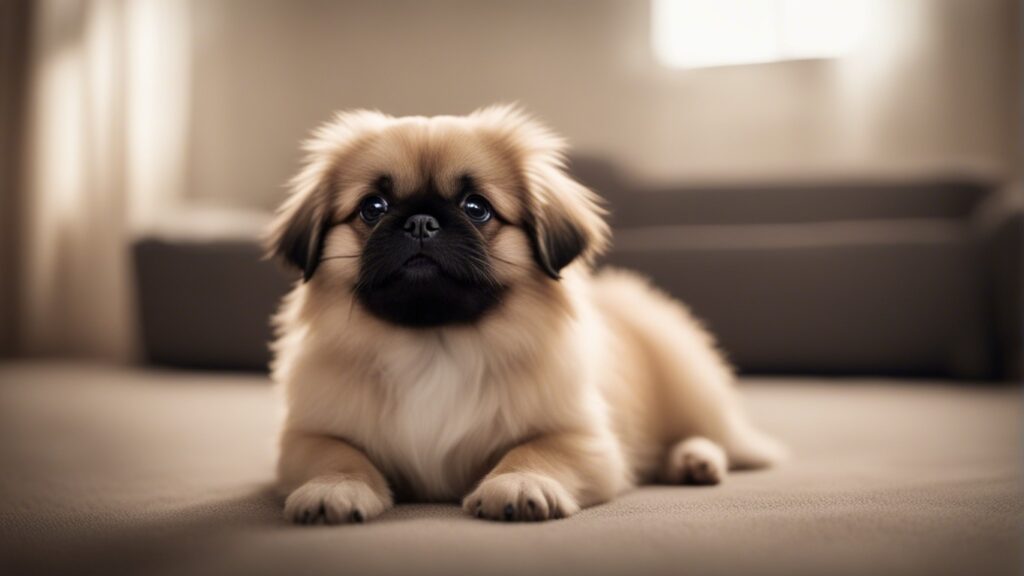
These steps get your Pekingese puppy off to the best start during its crucial first year. With its imperial heritage, the Pekingese naturally rules the roost—but don’t forget this breed craves companionship. Shower your regal Pekingese puppy with love, and you’ll have a loyal little sidekick.
The Dignified Yet Lively Pekingese
The Pekingese remains a commanding presence despite its petite size. These clever, confident dogs still carry themselves like the royalty they were bred to be for centuries. But today, the Pekingese bestow their affection on ordinary families, not just Chinese emperors.
With their courageous spirit, playful antics, and steadfast devotion, Pekingese puppies bring their brand of nobility into every household. They make faithful companions—as long as you don’t mind a bit of shedding from that flowing coat! Provide consistent training, proper socialization, and plenty of grooming, and the Pekingese will reward you with years of regal companionship.